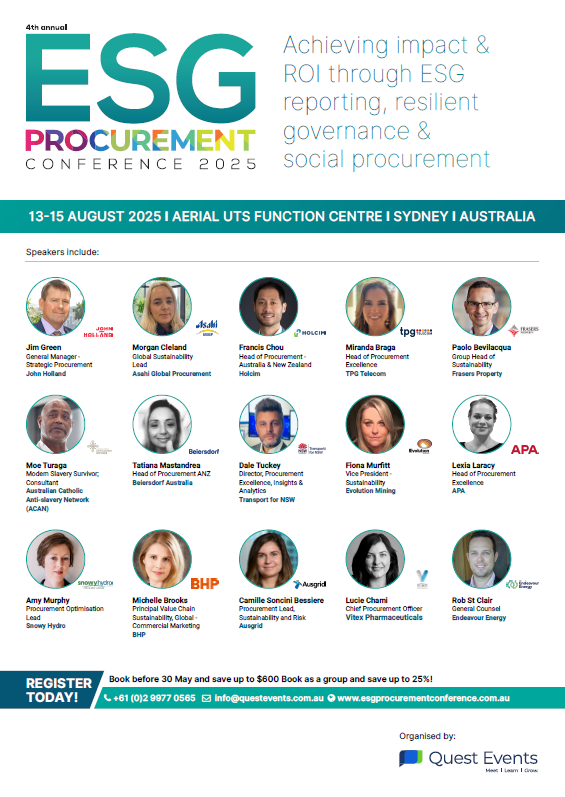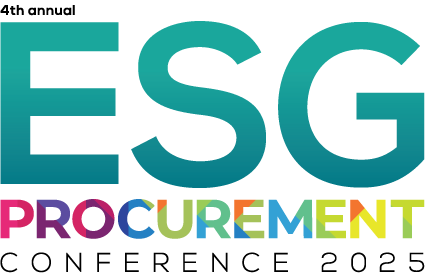Article: How to Improve Sustainability Reporting Outcomes in Procurement
.png?width=686&height=529&name=esg%20header%20(4).png)
With 2025 being the first reporting year for Group 1 entities under Australia's mandatory climate reporting regime, companies are finally moving from the planning to the execution phase. The new reporting requirements will reverberate up and down the supply chain, from larger organisations in Group 1 to smaller businesses facing indirect reporting obligations when they supply to Group 1 entities.
While some organisations – particularly those in compliance-heavy sectors – will take the reporting obligations in their stride, others face a steep learning curve.
Ahead of the 4th Annual ESG Procurement Conference 2025, Quest Events spoke with Kristen Maslen, Procurement Governance and Sustainability Manager at Medibank, Aidan Mullan, Sustainability Manager, Interface Australia and New Zealand, and Amanda Nuttall, Corporate Sustainability Leader at Aurecon, to discuss how organisations can achieve better reporting outcomes. Below, we share their insights into the key challenges faced in integrating sustainability reporting into procurement workflows, strategies for ensuring supplier alignment with sustainability objectives, and successful practices that have emerged.
What challenges have you faced in integrating sustainability reporting into procurement processes?
“Death by a thousand spreadsheets!” says Maslen. Those familiar with this challenge will recognise the usual headaches: data overload, gathering metrics from various sources, aggregation difficulties and a lack of standardisation. Resource intensity of manual data management is another issue as updating spreadsheets takes considerable time and has a higher risk of human error. In response, Medibank has engaged technology to help resolve this issue.
“For us, it’s around embedding sustainability considerations into procurement decision-making”, says Nuttall. “There are so many different elements that make up corporate sustainability. One moment we might be looking at carbon emissions analysis, then supporting Indigenous-owned supplier businesses, or putting a policy in place against modern slavery. The diverse nature of it is the key challenge; in terms of identifying the priorities, understanding the potential trade-offs and where the risks exist, then being able to access that level of information from suppliers.”
Nuttall points out that while large suppliers may be able to provide this information, we have to be more aware and nuanced when requesting sustainability-related data from less mature suppliers.
In Mullan’s experience, a key challenge lies with the turnover of procurement personnel. “As a result, the company has needed to put considerable resources into sustainability training for new recruits to ensure alignment with company purpose and continuity in our relationships with suppliers.”
Supplier alignment
For Maslen, supplier alignment involves a three-step process. “We use a tool to seek and select quality suppliers who support our sustainability goals. Next, we undertake due diligence at the onboarding stage, and finally suppliers are asked to review and abide by our supplier code.”
Both Interface and Aurecon similarly have codes of conduct that apply to suppliers and define key expectations and standards, including areas relating to ESG.
“That’s a standard we expect them to meet”, says Nuttall. “We also include questions and criteria around our sustainability priorities in tender requests , then consider responses as part of the selection criteria.”
The team asks for sustainability information when developing corporate procurement requests. This typically include topics such as sustainability strategies, carbon emissions data, diversity, equity and inclusion initiatives and management of modern slavery. The goal is for relevant disclosure requirements to be established at a contract level. “Whilst having a code of conduct that applies to our suppliers is important, getting it into the contract as a requirement is a much stronger driver”, Nuttall adds.
Managing the reporting burden on smaller suppliers
Nuttall adds that it’s important to recognise that suppliers of different shapes and sizes are at different stages of maturity in terms of reporting capability. “We’re currently in the process of developing a supplier engagement plan primarily around suppliers’ carbon emissions data”, she says. “Whilst the mandatory climate disclosure requirements are driving our activities, reporting itself isn’t the outcome. We want to promote climate action through our supply chain and the economy, so we need to support organisations to build capacity in a way that is appropriate given the nature of their business and their environmental impact. For instance, we shouldn’t place the same expectations around carbon and climate reporting on a small Indigenous-owned business supplier as we would on a large multi-national company.”
Mullan takes a similar approach. “We rate our key suppliers from low-level climate maturity to those that have net zero goals or science-based targets. In this way we can focus resources to achieve better alignment with those suppliers needing the most attention.”
Successful strategies
“Interface has focused on driving down the carbon impacts of its products and business processes”, says Mullan. “The key to success is ‘measuring to manage’ and we do this by applying a rigorous Life Cycle Assessment strategy to first identify the major sources of emissions, then to reduce those emissions or eliminate where possible. Adopting this LCA strategy means that all Interface products have product-specific Environmental Product Declarations (EPDs) that clearly define climate and environmental impacts.”
Reporting tech
“We can only manage what we can see”, notes Maslen. “Technology that enables visibility helps us build sustainable and resilient supply chains. We’ve implemented technology to provide a dashboard status view across all risk types and ESG factors per supplier.”
At Aurecon, Nuttall feels that the internally-built dashboards and reporting system works well, but now intends to focus on improving supply chain data from a carbon reporting perspective.
“We are actively investigating a range of technology options to improve the accuracy and integrity of our data. This includes considering platforms for collecting specific information regarding suppliers' ESG performance”, she explains. “
Nuttall notes that larger and more mature suppliers will have more of this data available online, so it is important to take more of a qualitative approach to less mature suppliers and work collaboratively with them.
At Interface, the team uses a software platform now referred to as “LCA for Experts”. “This software has allowed us to take a scientific approach to identifying our climate and environmental impacts, providing transparency of those impacts via our EPDs and reducing our footprint”, says Mullan. “We are currently assessing the possibility of using this to also measure social impacts of our business processes.”
Interested in learning more about improving climate reporting outcomes? Join us at the ESG Procurement Conference 2025 from 13th to 15th August at the Aerial UTS Function Centre, Sydney.
Download the Brochure


